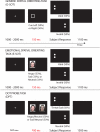Stimulus-Driven Attention, Threat Bias, and Sad Bias in Youth with a History of an Anxiety Disorder or Depression
- PMID: 25702927
- PMCID: PMC4547922
- DOI: 10.1007/s10802-015-9988-8
Stimulus-Driven Attention, Threat Bias, and Sad Bias in Youth with a History of an Anxiety Disorder or Depression
Abstract
Attention biases towards threatening and sad stimuli are associated with pediatric anxiety and depression, respectively. The basic cognitive mechanisms associated with attention biases in youth, however, remain unclear. Here, we tested the hypothesis that threat bias (selective attention for threatening versus neutral stimuli) but not sad bias relies on stimulus-driven attention. We collected measures of stimulus-driven attention, threat bias, sad bias, and current clinical symptoms in youth with a history of an anxiety disorder and/or depression (ANX/DEP; n = 40) as well as healthy controls (HC; n = 33). Stimulus-driven attention was measured with a non-emotional spatial orienting task, while threat bias and sad bias were measured at a short time interval (150 ms) with a spatial orienting task using emotional faces and at a longer time interval (500 ms) using a dot-probe task. In ANX/DEP but not HC, early attention bias towards threat was negatively correlated with later attention bias to threat, suggesting that early threat vigilance was associated with later threat avoidance. Across all subjects, stimulus-driven orienting was not correlated with early threat bias but was negatively correlated with later threat bias, indicating that rapid stimulus-driven orienting is linked to later threat avoidance. No parallel relationships were detected for sad bias. Current symptoms of depression but not anxiety were related to decreased stimulus-driven attention. Together, these results are consistent with the hypothesis that threat bias but not sad bias relies on stimulus-driven attention. These results inform the design of attention bias modification programs that aim to reverse threat biases and reduce symptoms associated with pediatric anxiety and depression.
Keywords: Adolescent; Anxiety; Attention bias; Depression; Sad bias; Stimulus-driven attention; Threat bias.
Figures


Similar articles
-
Written threat: Electrophysiological evidence for an attention bias to affective words in social anxiety disorder.Cogn Emot. 2016;30(3):516-38. doi: 10.1080/02699931.2015.1019837. Epub 2015 Mar 26. Cogn Emot. 2016. PMID: 25809672
-
Attentional bias for emotional faces in generalized anxiety disorder.Br J Clin Psychol. 1999 Sep;38(3):267-78. doi: 10.1348/014466599162845. Br J Clin Psychol. 1999. PMID: 10532148
-
Face processing in adolescents with positive and negative threat bias.Psychol Med. 2017 Apr;47(5):800-809. doi: 10.1017/S003329171600310X. Epub 2016 Nov 22. Psychol Med. 2017. PMID: 27873557 Free PMC article.
-
Systematic Review and Meta-Analysis: Eye-Tracking of Attention to Threat in Child and Adolescent Anxiety.J Am Acad Child Adolesc Psychiatry. 2020 Jan;59(1):88-99.e1. doi: 10.1016/j.jaac.2019.06.006. Epub 2019 Jun 29. J Am Acad Child Adolesc Psychiatry. 2020. PMID: 31265874
-
Attentional bias towards threatening stimuli in children with anxiety: A meta-analysis.Clin Psychol Rev. 2015 Aug;40:66-75. doi: 10.1016/j.cpr.2015.05.007. Epub 2015 Jun 3. Clin Psychol Rev. 2015. PMID: 26071667 Review.
Cited by
-
A Bottom-Up Validation of the IAPS, GAPED, and NAPS Affective Picture Databases: Differential Effects on Behavioral Performance.Front Psychol. 2020 Sep 4;11:2187. doi: 10.3389/fpsyg.2020.02187. eCollection 2020. Front Psychol. 2020. PMID: 33013565 Free PMC article.
-
Distinct Effects of Anxiety and Depression on Updating Emotional Information in Working Memory.Int J Environ Res Public Health. 2022 Dec 29;20(1):544. doi: 10.3390/ijerph20010544. Int J Environ Res Public Health. 2022. PMID: 36612866 Free PMC article.
-
Early Childhood Behavioral Inhibition Predicts Cortical Thickness in Adulthood.J Am Acad Child Adolesc Psychiatry. 2016 Feb;55(2):122-9.e1. doi: 10.1016/j.jaac.2015.11.007. Epub 2015 Nov 26. J Am Acad Child Adolesc Psychiatry. 2016. PMID: 26802779 Free PMC article.
-
School Anxiety in Children and Adolescents with Chronic Pain.Pain Res Manag. 2017;2017:8328174. doi: 10.1155/2017/8328174. Epub 2017 Sep 26. Pain Res Manag. 2017. PMID: 29081682 Free PMC article. Review.
-
Attention bias in adults with anorexia nervosa, obsessive-compulsive disorder, and social anxiety disorder.J Psychiatr Res. 2016 Aug;79:61-69. doi: 10.1016/j.jpsychires.2016.04.009. Epub 2016 Apr 29. J Psychiatr Res. 2016. PMID: 27174402 Free PMC article.
References
-
- Amir N, Elias J, Klumpp H, Przeworski A. Attentional bias to threat in social phobia: Facilitated processing of threat or difficulty disengaging attention from threat? Behaviour Research and Therapy. 2003;41:1325–1335. - PubMed
-
- Angold A, Costello EJ. The Child and Adolescent Psychiatric Assessment (CAPA). Journal of the American Academy of Child and Adolescent Psychiatry. 2000;39:39–48. doi: 10.1097/00004583-200001000-00015. - PubMed
-
- Bar-Haim Y, Lamy D, Pergamin L, Bakermans-Kranenburg MJ, van IJzendoorn MH. Threat-related attentional bias in anxious and nonanxious individuals: A meta-analytic study. Psychological Bulletin. 2007;133:1–24. doi: 10.1037/0033-2909.133.1.1. - PubMed
-
- Bar-Haim Y, Morag I, Glickman S. Training anxious children to disengage attention from threat: A randomized controlled trial. Journal of Child Psychology and Psychiatry. 2011;52:861–869. doi: 10.1111/j.1469-7610.2011.02368.x. - PubMed
-
- Bird HR, Gould MS, Staghezza B. Aggregating data from multiple informants in child psychiatry epidemiological research. Journal of the American Academy of Child and Adolescent Psychiatry. 1992;31:78–85. doi: 10.1097/00004583-199201000-00012. - PubMed
MeSH terms
Grants and funding
LinkOut - more resources
Full Text Sources
Other Literature Sources
Medical

